Search Thermo Fisher Scientific
Page Contents
Related Tables
Get Chapter Downloads from The Molecular Probes Handbook, 11th edition |
Our slow-response potential-sensitive probes ![]() (see Figure 22.1.1B in Introduction to Potentiometric Probes—Section 22.1) are listed in Characteristics and selected applications of Molecular Probes slow-response probes—Table 22.2, along with their charges, optical responses and selected applications.
(see Figure 22.1.1B in Introduction to Potentiometric Probes—Section 22.1) are listed in Characteristics and selected applications of Molecular Probes slow-response probes—Table 22.2, along with their charges, optical responses and selected applications.
DiI, DiS and DiO Derivatives
Indo- (DiI), thia- (DiS) and oxa- (DiO) carbocyanines with short alkyl tails (<7 carbon atoms) were among the first potentiometric fluorescent probes developed.![]() These cationic dyes accumulate on hyperpolarized membranes and are translocated into the lipid bilayer.
These cationic dyes accumulate on hyperpolarized membranes and are translocated into the lipid bilayer.![]() Aggregation within the confined membrane interior usually results in decreased fluorescence, although the magnitude and even the direction of the fluorescence response is strongly dependent on the concentration of the dye and its structural characteristics.
Aggregation within the confined membrane interior usually results in decreased fluorescence, although the magnitude and even the direction of the fluorescence response is strongly dependent on the concentration of the dye and its structural characteristics.![]() While the distribution of extracellularly applied dye is dependent on both the plasma and mitochondrial membrane potentials, the primary determinant is the latter. Very low applied concentrations (<100 nM) are required to obtain mitochondrial signal specificity and avoid potential-independent background derived from staining of the endoplasmic reticulum and other intracellular membranes.
While the distribution of extracellularly applied dye is dependent on both the plasma and mitochondrial membrane potentials, the primary determinant is the latter. Very low applied concentrations (<100 nM) are required to obtain mitochondrial signal specificity and avoid potential-independent background derived from staining of the endoplasmic reticulum and other intracellular membranes.
DiOC6(3) (D273) has been the most widely used carbocyanine dye for membrane potential measurements,![]() followed closely by DiOC5(3); see Characteristics and selected applications of Molecular Probes slow-response probes—Table 22.2 for selected references. In flow cytometry measurements, the detected intensity of carbocyanine fluorescence is dependent not only on the membrane potential, but also on cell size. In some cases, measurements of forward light scatter have been used to normalize the optical changes for cell size variability. A fluorescence ratio method (Figure 22.3.1) that exploits a potential-dependent red shift in the emission spectrum of DiOC2(3) (D14730) has been developed for membrane potential measurements in bacteria
followed closely by DiOC5(3); see Characteristics and selected applications of Molecular Probes slow-response probes—Table 22.2 for selected references. In flow cytometry measurements, the detected intensity of carbocyanine fluorescence is dependent not only on the membrane potential, but also on cell size. In some cases, measurements of forward light scatter have been used to normalize the optical changes for cell size variability. A fluorescence ratio method (Figure 22.3.1) that exploits a potential-dependent red shift in the emission spectrum of DiOC2(3) (D14730) has been developed for membrane potential measurements in bacteria ![]() (B34950, see below). The 633 nm light–excitable indodicarbocyanine DiIC1(5)
(B34950, see below). The 633 nm light–excitable indodicarbocyanine DiIC1(5) ![]() enables analysis of mitochondrial potential in apoptotic cells in combination with fluoresceinated annexin V
enables analysis of mitochondrial potential in apoptotic cells in combination with fluoresceinated annexin V ![]() (A13199, Assays for Apoptosis—Section 15.5), a method we have utilized in two of our MitoProbe Assay Kits for flow cytometry (M34150, M34151; see below). Carbocyanine dyes, particularly thiacyanines such as DiSC3(5) (D306), can inhibit respiration
(A13199, Assays for Apoptosis—Section 15.5), a method we have utilized in two of our MitoProbe Assay Kits for flow cytometry (M34150, M34151; see below). Carbocyanine dyes, particularly thiacyanines such as DiSC3(5) (D306), can inhibit respiration ![]() and may therefore be relatively cytotoxic.
and may therefore be relatively cytotoxic.![]()
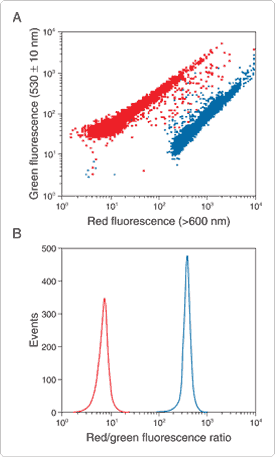
Figure 22.3.1 A) Two-color flow cytometric analysis of Staphylococcus aureus populations stained with 30 µM DiOC2(3) (D14730) in the presence (red) or absence (blue) of the metabolic uncoupler carbonyl cyanide m-chlorophenylhydrazone (CCCP). Note the variability (~100-fold range) of the green and red fluorescence intensities. B) The same data expressed as red/green fluorescence intensity ratios. Ratio values are calculated by subtracting the logarithmic green fluorescence channel value from the corresponding logarithmic red fluorescence channel value.![]() Figure supplied by Howard M. Shapiro, Harvard Medical School, Boston, MA.
Figure supplied by Howard M. Shapiro, Harvard Medical School, Boston, MA.
JC-1 and JC-9
JC-1 (5,5',6,6'-tetrachloro-1,1',3,3'-tetraethylbenzimidazolylcarbocyanine iodide, T3168) exists as a green-fluorescent monomer at low concentrations or at low membrane potential. However, at higher concentrations (aqueous solutions above 0.1 µM) or higher potentials, JC-1 forms red-fluorescent "J-aggregates," which exhibit a broad excitation spectrum and a very narrow emission spectrum (![]() ). Because J-aggregate formation increases linearly with applied membrane potential over the range of 30–180 mV, this phenomenon can be exploited for potentiometric measurements
). Because J-aggregate formation increases linearly with applied membrane potential over the range of 30–180 mV, this phenomenon can be exploited for potentiometric measurements ![]() (Characteristics and selected applications of Molecular Probes slow-response probes—Table 22.2). JC-1 is more specific for mitochondrial versus plasma membrane potential and more consistent in its response to depolarization than some other cationic dyes such as DiOC6(3) and rhodamine 123.
(Characteristics and selected applications of Molecular Probes slow-response probes—Table 22.2). JC-1 is more specific for mitochondrial versus plasma membrane potential and more consistent in its response to depolarization than some other cationic dyes such as DiOC6(3) and rhodamine 123.![]()
Various types of ratio measurements are possible by combining signals from the green-fluorescent JC-1 monomer (absorption/emission maxima ~514/529 nm) and the red-fluorescent J-aggregate (absorption/emission maxima ~585/590 nm), which can be effectively excited anywhere between 485 nm and its absorption maximum. Optical filters designed for fluorescein and tetramethylrhodamine can be used to separately visualize the monomer and J-aggregate forms, respectively. Alternatively, both forms can be observed simultaneously using a fluorescein longpass optical filter set. For flow cytometry, JC-1 can be excited at 488 nm and detected in bivariate mode using the green channel for the monomer and the red channel for the J-aggregate form ![]() (Figure 22.3.2).
(Figure 22.3.2).
JC-1 is widely used for detecting mitochondrial depolarization in apoptotic cells ![]() (MitoProbe JC-1 Assay Kit, M34152, described below) and for assaying multidrug-resistant cells
(MitoProbe JC-1 Assay Kit, M34152, described below) and for assaying multidrug-resistant cells ![]() (Probes for Cell Adhesion, Chemotaxis, Multidrug Resistance and Glutathione—Section 15.6). It is also frequently employed for mitochondrial function assessment in cell-based high-throughput assays.
(Probes for Cell Adhesion, Chemotaxis, Multidrug Resistance and Glutathione—Section 15.6). It is also frequently employed for mitochondrial function assessment in cell-based high-throughput assays.![]() We have discovered another carbocyanine dye, JC-9 (3,3'-dimethyl-α-naphthoxacarbocyanine iodide, D22421), with potential-dependent spectroscopic properties (
We have discovered another carbocyanine dye, JC-9 (3,3'-dimethyl-α-naphthoxacarbocyanine iodide, D22421), with potential-dependent spectroscopic properties (![]() ) similar to those of JC-1 for detecting mitochondrial depolarization in apoptotic cells.
) similar to those of JC-1 for detecting mitochondrial depolarization in apoptotic cells.![]()
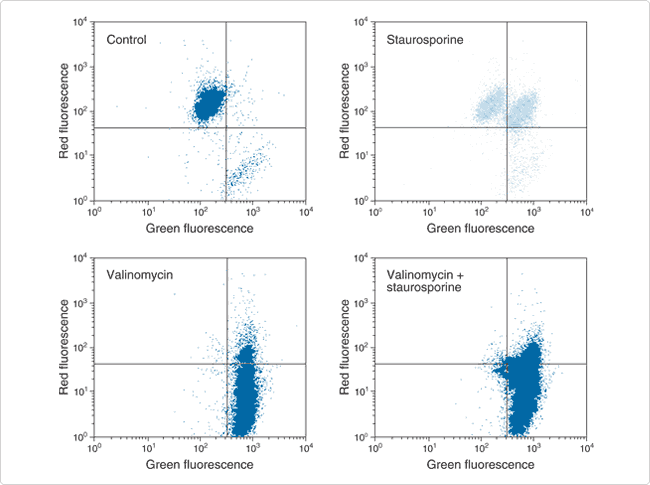
MitoProbe JC-1 Assay Kit for Flow Cytometry
The MitoProbe JC-1 Assay Kit (M34152) provides the cationic dye JC-1 and a mitochondrial membrane potential disrupter, CCCP (carbonyl cyanide 3-chlorophenylhydrazone), for the study of mitochondrial membrane potential. Use of JC-1 fluorescence ratio detection allows researchers to make comparative measurements of membrane potential and to determine the percentage of mitochondria within a population that respond to an applied stimulus (Figure 22.3.3). Subtle heterogeneity in cellular responses can be discerned in this way.![]() For example, four distinct patterns of mitochondrial membrane potential change in response to glutamate receptor activation in neurons have been identified using confocal ratio imaging of JC-1 fluorescence.
For example, four distinct patterns of mitochondrial membrane potential change in response to glutamate receptor activation in neurons have been identified using confocal ratio imaging of JC-1 fluorescence.![]()
Each MitoProbe JC-1 Assay Kit provides:
- JC-1
- Dimethylsulfoxide (DMSO)
- CCCP
- Concentrated phosphate-buffered saline (PBS)
- Detailed protocols (MitoProbe JC-1 Assay Kit for Flow Cytometry)
Sufficient reagents are provided for 100 assays, based on a labeling volume of 1 mL.
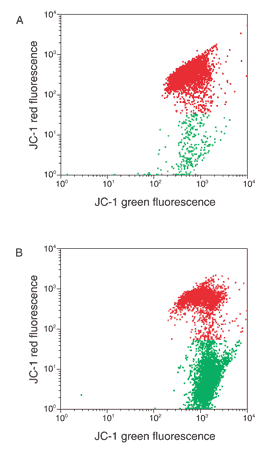
Figure 22.3.3 Flow cytometric analysis of Jurkat cells using the MitoProbe JC-1 Assay Kit (M34152). Jurkat cells were stained with 2 µM JC-1 for 15 minutes at 37°C, 5% CO2, and then washed with phosphate-buffered saline (PBS) and analyzed on a flow cytometer using 488 nm excitation with 530 nm and 585 nm bandpass emission filters. Untreated cultured cells are shown in panel A. Panel B shows cells induced to apoptosis with 10 µM camptothecin for 4 hours at 37°C.
MitoProbe DiIC1(5) and MitoProbe DiOC2(3) Assay Kits for Flow Cytometry
The MitoProbe DiIC1(5) and MitoProbe DiOC2(3) Assay Kits (M34151, M34150) provide solutions of the far-red–fluorescent DiIC1(5) (1,1',3,3,3',3'-hexamethylindodicarbocyanine iodide) and green-fluorescent DiOC2(3) (3,3'-diethyloxacarbocyanine iodide) carbocyanine dyes, respectively, along with a mitochondrial membrane potential uncoupler, CCCP, for the study of mitochondrial membrane potential. These DiIC1(5) and DiOC2(3) carbocyanine dyes penetrate the cytosol of eukaryotic cells and, at concentrations below 100 nM, accumulate primarily in mitochondria with active membrane potentials. In the case of DiOC2(3), this accumulation is accompanied by a shift from green to red emission due to dye stacking (Figure 22.3.1), allowing the use of a ratiometric parameter (red/green fluorescence ratio) that corrects for size differences when measuring membrane potential in bacteria.![]() DiOC2(3) can be paired with other reagents, such as the far-red–fluorescent allophycocyanin annexin V (A35110, Assays for Apoptosis—Section 15.5) or TO-PRO-3 nucleic acid stain (T3605, Nucleic Acid Stains—Section 8.1) for multiparameter study of vitality and apoptosis
DiOC2(3) can be paired with other reagents, such as the far-red–fluorescent allophycocyanin annexin V (A35110, Assays for Apoptosis—Section 15.5) or TO-PRO-3 nucleic acid stain (T3605, Nucleic Acid Stains—Section 8.1) for multiparameter study of vitality and apoptosis ![]() (Figure 22.3.4).
(Figure 22.3.4).
The MitoProbe DiIC1(5) and MitoProbe DiOC2(3) Assay Kits provide:
- DiIC1(5) (in Kit M34151) or DiOC2(3) (in Kit M34150)
- CCCP
- Detailed protocols for labeling cells (MitoProbe DiIC1(5) Assay Kit for Flow Cytometry, MitoProbe DiOC2(3) Assay Kit for Flow Cytometry)
Each kit provides sufficient reagents for 100 assays, based on a labeling volume of 1 mL.
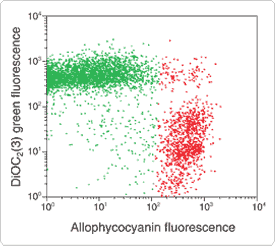
Figure 22.3.4 Flow cytometric analysis of camptothecin-treated Jurkat cells stained with DiOC2(3) (D14730, M34150) and allophycocyanin annexin V (A35110). Jurkat cells were incubated for 4 hours with camptothecin at 37°C, 5% CO2, then stained with 50 nM DiOC2(3) and allophycocyanin annexin V. Cells were analyzed on a flow cytometer using 488 nm and 633 nm excitations with 530 nm and 660 nm bandpass emission filters.
BacLight Bacterial Membrane Potential Kit
The BacLight Bacterial Membrane Potential Kit (B34950) provides a fluorescent membrane-potential indicator dye, DiOC2(3), along with a proton ionophore (CCCP) and premixed buffer. At low concentrations, DiOC2(3) exhibits green fluorescence in all bacterial cells, but it becomes more concentrated in healthy cells that are maintaining a membrane potential, causing the dye to self-associate and the fluorescence emission to shift to red. The red- and green-fluorescent bacterial populations are easily distinguished using a flow cytometer (Figure 22.3.5). CCCP is included in the kit for use as a control because it eradicates the proton gradient, eliminating bacterial membrane potential.![]()
Each BacLight Bacterial Membrane Potential Kit contains:
- DiOC2(3) in dimethylsulfoxide (DMSO)
- CCCP in DMSO
- Phosphate-buffered saline (PBS)
- Detailed protocols (BacLight Bacterial Membrane Potential Kit)
Using the recommended reagent dilutions and volumes, this kit provides sufficient DiOC2(3) to perform approximately 100 individual assays by flow cytometry; sufficient CCCP is provided for 30 depolarized control samples. The BacLight Bacterial Membrane Potential Kit is designed to assay bacterial concentrations between 105 and 107 organisms per mL. Note that DiOC2(3) and CCCP are inhibitors of respiration, rendering the cells nonculturable beyond the brief time window required for staining and analysis.
Using the BacLight Bacterial Membrane Potential Kit, we have detected membrane potentials in all bacteria tested (including logarithmically growing cultures of Micrococcus luteus, Staphylococcus aureus, Bacillus cereus, Staphylococcus warnerii, Escherichia coli and Salmonella choleraesuis), although the magnitude varies with species (Figure 22.3.6).
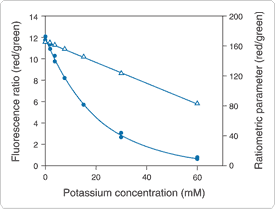
Figure 22.3.5 Response of Staphylococcus aureus to valinomycin and external potassium ions, as measured by flow cytometry using the BacLight Bacterial Membrane Potential Kit (B34950). Samples containing S. aureus were treated with 5 µM valinomycin in different concentrations of potassium buffer, and then stained using 30 µM DiOC2(3) for 30 minutes, according to the kit protocol. Data are expressed either using a ratiometric parameter based on the formula provided in the kit protocol (triangles, right axis) or as the ratio of population mean red-fluorescence intensity/mean green-fluorescence intensity (circles, left axis).
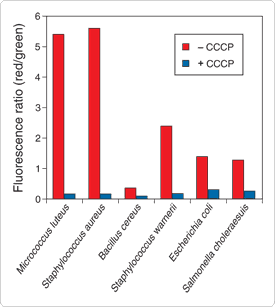
Figure 22.3.6 Detection of membrane potential in various bacteria with the BacLight Bacterial Membrane Potential Kit (B34950). Red/green fluorescence ratios were calculated using population mean fluorescence intensities for gram-positive (Micrococcus luteus, Staphylococcus aureus, Bacillus cereus and Staphylococcus warnerii) and gram-negative (Escherichia coli and Salmonella choleraesuis) bacteria incubated with 30 µM DiOC2(3) for 30 minutes in either the presence or absence of 5 µM CCCP, according to the kit protocol.
Rhodamine 123 (R302) is widely used as a structural marker for mitochondria (Probes for Mitochondria—Section 12.2) and as an indicator of mitochondrial activity (Viability and Cytotoxicity Assay Reagents—Section 15.2, ![]() ). Highly selective, potential-dependent staining of mitochondria is obtained by setting the extracellular K+ concentration close to intracellular values (~137 mM), thereby depolarizing the plasma membrane.
). Highly selective, potential-dependent staining of mitochondria is obtained by setting the extracellular K+ concentration close to intracellular values (~137 mM), thereby depolarizing the plasma membrane.![]()
TMRM (T668) and TMRE (T669), the methyl and ethyl esters of tetramethylrhodamine are closely related to rhodamine 123. They are primarily mitochondrial membrane potential sensors.![]() As with rhodamine 123, accumulation of these cationic dyes in mitochondria results in diminished fluorescence due to self-quenching
As with rhodamine 123, accumulation of these cationic dyes in mitochondria results in diminished fluorescence due to self-quenching ![]() (
(![]() ). TMRM and TMRE cross the plasma membrane more rapidly than rhodamine 123, and their strong fluorescence allows the use of low probe concentrations, thus avoiding aggregation. Because their fluorescence is relatively insensitive to the environment, spatially resolved fluorescence of TMRM and TMRE presents an unbiased profile of their transmembrane distribution that can be directly related to the plasma membrane potential via the Nernst equation.
). TMRM and TMRE cross the plasma membrane more rapidly than rhodamine 123, and their strong fluorescence allows the use of low probe concentrations, thus avoiding aggregation. Because their fluorescence is relatively insensitive to the environment, spatially resolved fluorescence of TMRM and TMRE presents an unbiased profile of their transmembrane distribution that can be directly related to the plasma membrane potential via the Nernst equation.![]() TMRE has been successfully used in a high-throughput screening assay for drugs that affect mitochondrial membrane potential in live cells.
TMRE has been successfully used in a high-throughput screening assay for drugs that affect mitochondrial membrane potential in live cells.![]() TMRM has been used in conjunction with X-rhod-1 AM (X14210, Fluorescent Ca2+ Indicators Excited with Visible Light—Section 19.3) for simultaneous confocal imaging of mitochondrial membrane potential and calcium in rat cardiomyocytes.
TMRM has been used in conjunction with X-rhod-1 AM (X14210, Fluorescent Ca2+ Indicators Excited with Visible Light—Section 19.3) for simultaneous confocal imaging of mitochondrial membrane potential and calcium in rat cardiomyocytes.![]()
Oxonol V and Oxonol VI
The anionic bis-isoxazolone oxonols accumulate in the cytoplasm of depolarized cells by a Nernst equilibrium–dependent uptake from the extracellular solution.![]() Their voltage-dependent partitioning between water and membranes is often measured by absorption rather than fluorescence. Of the oxonols studied by Smith and Chance,
Their voltage-dependent partitioning between water and membranes is often measured by absorption rather than fluorescence. Of the oxonols studied by Smith and Chance,![]() oxonol VI gave the largest spectral shifts, with an isosbestic point at 603 nm. In addition, oxonol VI responds to changes in potential more rapidly than oxonol V and is therefore considered to be the better probe for measuring fast potential changes.
oxonol VI gave the largest spectral shifts, with an isosbestic point at 603 nm. In addition, oxonol VI responds to changes in potential more rapidly than oxonol V and is therefore considered to be the better probe for measuring fast potential changes.![]()
DiBAC (Bis-Oxonol) Dyes
The three bis-barbituric acid oxonols, often referred to as DiBAC dyes, form a family of spectrally distinct potentiometric probes with excitation maxima at approximately 490 nm (DiBAC4(3); B438), 530 nm (DiSBAC2(3), B413) and 590 nm (DiBAC4(5)). Several papers have referred to these dyes simply as "bis-oxonol" and it is not always possible to determine which of the dyes was employed; however, DiBAC4(3) has been used in the majority of publications that cite a "bis-oxonol."
These dyes enter depolarized cells where they bind to intracellular proteins or membranes and exhibit enhanced fluorescence and red spectral shifts.![]() Increased depolarization results in more influx of the anionic dye and thus an increase in fluorescence (
Increased depolarization results in more influx of the anionic dye and thus an increase in fluorescence (![]() ). Conversely, hyperpolarization is indicated by a decrease in fluorescence (Figure 22.3.7). In contrast to cationic carbocyanines, anionic bis-oxonols are largely excluded from mitochondria and are primarily sensitive to plasma membrane potential. Potential-dependent fluorescence changes generated by DiBAC4(3) are typically ~1% per mV.
). Conversely, hyperpolarization is indicated by a decrease in fluorescence (Figure 22.3.7). In contrast to cationic carbocyanines, anionic bis-oxonols are largely excluded from mitochondria and are primarily sensitive to plasma membrane potential. Potential-dependent fluorescence changes generated by DiBAC4(3) are typically ~1% per mV.![]() Interactions between anionic oxonols and the cationic K+-valinomycin complex complicate the use of this ionophore when calibrating potentiometric responses.
Interactions between anionic oxonols and the cationic K+-valinomycin complex complicate the use of this ionophore when calibrating potentiometric responses.![]() Oxonol dyes have known pharmacological activity against various ion channels and receptors.
Oxonol dyes have known pharmacological activity against various ion channels and receptors.![]() It is therefore important to establish, as is the case in any experiment using fluorescent probes, that experimental observations with implied physiological significance are independent of the externally applied probe concentration.
It is therefore important to establish, as is the case in any experiment using fluorescent probes, that experimental observations with implied physiological significance are independent of the externally applied probe concentration.

Figure 22.3.7 Detection of ATP-sensitive potassium (KATP) channel activation in isolated capillaries from guinea pig hearts using DiBAC4(3) (B438), a slow potentiometric probe. Application of a K+ channel opener (HOE 234) induced membrane hyperpolarization, resulting in a net efflux of intracellular DiBAC4(3), which is registered as a decrease of fluorescence intensity. These effects were reversed by subsequent treatment with the channel blocker glibenclamide. Figure reproduced with permission from ![]() .
.
Although merocyanine 540 was among the first fluorescent dyes to be used as a potentiometric probe,![]() its use for this application has declined with the advent of superior probes. A significant disadvantage of merocyanine 540 is its extreme phototoxicity; consequently, it is now more commonly used as a photosensitizer.
its use for this application has declined with the advent of superior probes. A significant disadvantage of merocyanine 540 is its extreme phototoxicity; consequently, it is now more commonly used as a photosensitizer.![]()
Merocyanine 540 exhibits a biphasic kinetic response to membrane polarization changes. It binds to the surface of polarized membranes in a perpendicular orientation, reorienting as the membrane depolarizes to form nonfluorescent dimers with altered absorption spectra.![]() This fast (microseconds) reorientation is followed by a slower response caused by an increased dye uptake.
This fast (microseconds) reorientation is followed by a slower response caused by an increased dye uptake.
Merocyanine 540 is also a useful probe of lipid packing because it binds preferentially to membranes with highly disordered lipids.![]() Fluorescence of merocyanine 540 is sensitive to heat-induced changes in the organization of membrane lipids.
Fluorescence of merocyanine 540 is sensitive to heat-induced changes in the organization of membrane lipids.![]()
For a detailed explanation of column headings, see Definitions of Data Table Contents
| Cat. No. | MW | Storage | Soluble | Abs | EC | Em | Solvent | Notes |
|---|---|---|---|---|---|---|---|---|
| B413 DiSBAC2(3) | 436.54 | L | DMSO, EtOH | 535 | 170,000 | 560 | MeOH | 1 |
| DiBAC4(5) | 542.67 | L | DMSO, EtOH | 590 | 160,000 | 616 | MeOH | 1 |
| B438 DiBAC4(3) | 516.64 | L | DMSO, EtOH | 493 | 140,000 | 516 | MeOH | 1, 2 |
| D273 DiOC6(3) | 572.53 | D,L | DMSO | 484 | 154,000 | 501 | MeOH | |
| D306 DiSC3(5) | 546.53 | D,L | DMSO | 651 | 258,000 | 675 | MeOH | |
| D14730 DiOC2(3) | 460.31 | D,L | DMSO | 482 | 165,000 | 497 | MeOH | 3 |
| D22421 JC-9 (DiNOC1(3)) | 532.38 | D,L | DMSO, DMF | 522 | 143,000 | 535 | CHCl3 | 4 |
| DiIC1(5) | 510.46 | L | DMSO | 638 | 230,000 | 658 | MeOH | 5 |
| merocyanine 540 | 569.67 | D,L | DMSO, EtOH | 555 | 143,000 | 578 | MeOH | |
| oxonol V | 384.39 | L | DMSO, EtOH | 610 | 135,000 | 639 | MeOH | 1 |
| oxonol VI | 316.36 | L | DMSO, EtOH | 599 | 136,000 | 634 | MeOH | 1 |
| R302 rhodamine 123 | 380.83 | F,D,L | MeOH, DMF | 507 | 101,000 | 529 | MeOH | |
| T668 tetramethylrhodamine, methyl ester (TMRM) | 500.93 | F,D,L | DMSO, MeOH | 549 | 115,000 | 573 | MeOH | |
| T669 tetramethylrhodamine, ethyl ester (TMRE) | 514.96 | F,D,L | DMSO, EtOH | 549 | 109,000 | 574 | MeOH | |
| T3168 JC-1 (CBIC2(3)) | 652.23 | D,L | DMSO, DMF | 514 | 195,000 | 529 | MeOH | 6 |
| ||||||||
For Research Use Only. Not for use in diagnostic procedures.